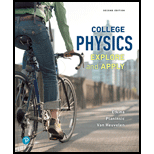
Concept explainers
The effect on the number of ejected electrons per unit time on increasing the
a. The number of electrons remains same because one photon can only eject one electron.
b. The number of electrons increases because each photon can be absorbed by two neighboring electrons.
c. The number of electrons increases because a photon can collide with an electron, transfering a part of its energy to the electron as it scatters, and then collides with other surrounding electrons. As long as the photon has enough energy, it will eject an electron at each collision.
d. The number of electrons decreases because we need fewer photons with larger frequency to maintain the same intensity of light.
e. The number of electrons decreases because photons with a higher frequency have a lower probability of colliding with electrons than low-frequency photons.
Want to see the full answer?
Check out a sample textbook solution
Chapter 27 Solutions
College Physics
- Engineers are frequently called on to inspect and, if necessary, repair equipment in medical hospitals. Suppose that the PET system malfunctions. After inspecting the unit, you suspect that one of the PET photon detectors is misaligned. To test your theory you position one detector at die location (r,,)=(1.5,45,30)relative to a radioactive test sample at the center of the patient bed. (a) If the second photon detector is properly aligned where should it be located? (b) What energy reading is expected?arrow_forwardSingly ionized atomic helium He +1 is a hydrogen-like ion. (a) What is its ground-state radius? (b) Calculate the energies of its four lowest energy states. (c) Repeat the calculations for the Li2+ - ion.arrow_forwardTanning salons use "safe" UV with a longer wavelength than some of the UV in sunlight. This "safe" UV has enough photon energy to trigger the tanning mechanism. Is it likely to be able to cause cell damage and induce cancer with prolonged exposure?arrow_forward
- Atomic and molecular spectra are discrete. What does discrete mean, and how are discrete spectra related to the quantization of energy and electron orbits in atoms and molecules?arrow_forwardHow do the allowed orbits for electrons in atoms differ from the allowed orbits for planets around the sun? Explain how the correspondence principle applies here.arrow_forwardThe image represents the gaps between allowed energy levels for electrons. Which model best describes this phenomenon? A. the wave model because electrons orbit the atom's nucleus in a continuous way B. the particle model because electrons are particles C. the wave model because the arrows show that the energy transfer is continuous D. the particle model because the arrows represent discrete particle-like jumpsarrow_forward
- the n= tate. vels for Hydrogen. rbed photon? + tion from the thi 4. A light bulb used in a slide projector draws a current of 6 amperes when operating on 120 volts. a. What is the resistance of the light bulbs in ohms? b. What is the power consumed by the light bulb in watts? C. If two identical slide projectors are connected in parallel across the same 120 Volt source, what is the total current drawn from the source?arrow_forwardThe first three energy levels of the fictitious element X are as shown.a. What wavelengths are observed in the absorption spectrum of element X? Give your answers in nm.b. State whether each of your wavelengths in part a corresponds to ultraviolet, visible, or infrared light.c. An electron with a speed of 1.4 × 106 m/s collides with an atom of element X. Shortly afterward, the atom emits a 1240 nm photon. What was the electron’s speed after the collision? Assume that, because the atom is so much more massive than the electron, the recoil of the atom is negligible.arrow_forwardWhich of the following provides evidence to the wave nature of electrons? A. In the photoelectric effect experiment, electrons are ejected from the metal. B. Louie de Broglie derived the equation for the wavelength of an electron. C. Interference patterns were exhibited by electrons in the double-slit experiment. D. In the Compton experiment, photon’s energy is transferred to the recoiling electron.arrow_forward
 University Physics Volume 3PhysicsISBN:9781938168185Author:William Moebs, Jeff SannyPublisher:OpenStax
University Physics Volume 3PhysicsISBN:9781938168185Author:William Moebs, Jeff SannyPublisher:OpenStax Physics for Scientists and Engineers with Modern ...PhysicsISBN:9781337553292Author:Raymond A. Serway, John W. JewettPublisher:Cengage Learning
Physics for Scientists and Engineers with Modern ...PhysicsISBN:9781337553292Author:Raymond A. Serway, John W. JewettPublisher:Cengage Learning College PhysicsPhysicsISBN:9781285737027Author:Raymond A. Serway, Chris VuillePublisher:Cengage Learning
College PhysicsPhysicsISBN:9781285737027Author:Raymond A. Serway, Chris VuillePublisher:Cengage Learning Glencoe Physics: Principles and Problems, Student...PhysicsISBN:9780078807213Author:Paul W. ZitzewitzPublisher:Glencoe/McGraw-Hill
Glencoe Physics: Principles and Problems, Student...PhysicsISBN:9780078807213Author:Paul W. ZitzewitzPublisher:Glencoe/McGraw-Hill College PhysicsPhysicsISBN:9781938168000Author:Paul Peter Urone, Roger HinrichsPublisher:OpenStax College
College PhysicsPhysicsISBN:9781938168000Author:Paul Peter Urone, Roger HinrichsPublisher:OpenStax College





